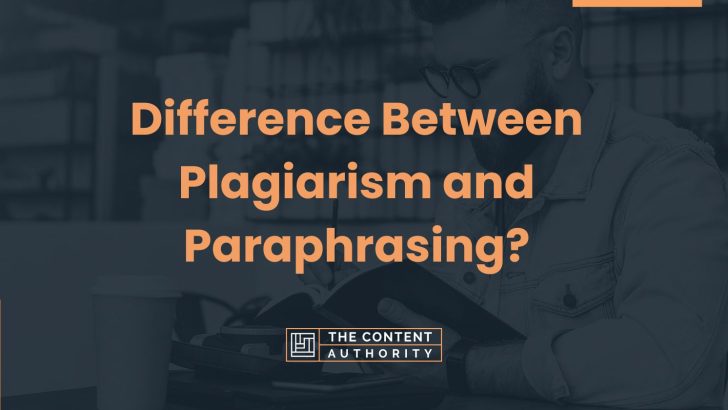When we think of writing, two terms immediately come to mind. These terms are plagiarism and paraphrasing. These terms represent two different practices in writing. However, both practices often cross paths because people need help understanding their differences. Some people even try to confuse paraphrasing with plagiarism, but if done properly, paraphrasing has nothing to do with plagiarism.
However, poor paraphrasing can lead to plagiarism. Hence, many people avoid paraphrasing content just to avoid plagiarism.
Paraphrasing is an essential writing skill often taught at the academic level to help students use it correctly during their academic and professional careers. Still, you will find people needing help understanding the difference between both these terms and the practices they relate to.
This article will outline the difference between plagiarism and paraphrasing. It will help readers understand how plagiarism can be identified and avoided. Moreover, users will learn how to paraphrase content by reading this article.
Plagiarism
Plagiarism, in simple terms, is defined as the act of stealing someone else’s words or ideas and presenting them as yours. This practice is considered unethical and unappreciated everywhere, including academia, the marketing industry, and the corporate landscape. The person found involved in the act of plagiarism faces various uncalled-for consequences.
Take the example of academia; students involved in plagiarism face consequences like failure, fewer grades, rustication, and expulsion. The same is true for professionals; the person found to publish or write plagiarised content loses their job and hard-earned trust. Additionally, plagiarism causes serious damage to reputation.
How does Plagiarism Occur?
Plagiarism occurs due to multiple reasons. Sometimes, it is intentional, but in most cases, it occurs accidentally. Intentional plagiarism includes scrapping content from elsewhere without accrediting the actual author. In contrast, accidental plagiarism may happen due to a lack of substantial research, matched writing style, failure to cite sources, and duplication with previously written content.
While multiple types of intentional plagiarism exist, the most prominent ones are mosaic and patchwork.
Mosaic plagiarism means scrapping exact words from another source for inclusion in the content. In contrast, patchwork plagiarism is the act of combining content scrapped from various sources in addition to a write-up.
Ways to Avoid Plagiarism
Plagiarism, whether accidental or intentional, can be avoided easily. Here are some ways to avoid plagiarism and ensure unique content.
- Taking the help of multiple resources to perform substantial research.
- Citing sources properly in the recommended format.
- Checking plagiarism using an efficient plagiarism checker online.
Paraphrasing
Paraphrasing is rewriting content in your own words and keeping the intended meaning of content similar. This practice finds its uses in multiple places. Students use paraphrasing to add quotations to their essays, assignments, and dissertations in paraphrased form to avoid excessive duplication. Research and writers do the same to ensure unique research papers and write-ups.
Paraphrasing requires writers to use multiple techniques to ensure the same meaning but different wording. It is worth mentioning that a poor paraphrase may lead to plagiarism allegations. Hence, writers must read the original content multiple times and understand it properly before rewriting it to ensure they can define something in their own words while keeping the meaning the same.
What Can Go Wrong with Paraphrasing?
Paraphrasing, by definition, may sound simple to an average Joe. However, it is more complex than it sounds. It takes substantial practice and skill to paraphrase content and rewrite it in different wording but with the same meaning.
Many experienced writers may also do poor paraphrasing that may need more meaning or fall into the category of plagiarism.
Manual paraphrasing can be tricky, especially with limited vocabulary in a particular language. Many words are used as synonyms to each other. However, when such words are used in paraphrases, they may not fit the context. Duplication, grammar mistakes, and vague sentences could also be a problem.
Techniques to Paraphrase Content Rightly
Paraphrasing content properly requires you to use multiple techniques to ensure that the paraphrased content you generate is grammatically correct and doesn’t include duplication or plagiarism. Here are some techniques to do it.
- Replace prominent words with their contextually meaningful synonyms.
- Alter voices of sentences.
- Change the structure of the sentence.
- Change the form of words.
However, if you still need to practice paraphrasing content correctly, you can use an advanced paraphrasing tool. Such a tool will help you ensure properly paraphrased content, avoid plagiarism, and enhance clarity.
Putting it Together
Paraphrasing and plagiarism are different practices. While paraphrasing is taught to help students ensure unique content, plagiarism is disliked because it is considered unethical. Both practices can cross their ways if the need to paraphrase content arises due to identified plagiarism or when the need to add sourced content emerges.
Nevertheless, both these practices are different to each other. Identifying plagiarism is easier with the help of a plagiarism checker, while a paraphrasing tool can help people rephrase content perfectly.
We have discussed everything you need to differentiate between these two terms. Hopefully, you will learn a lot from this writing!

